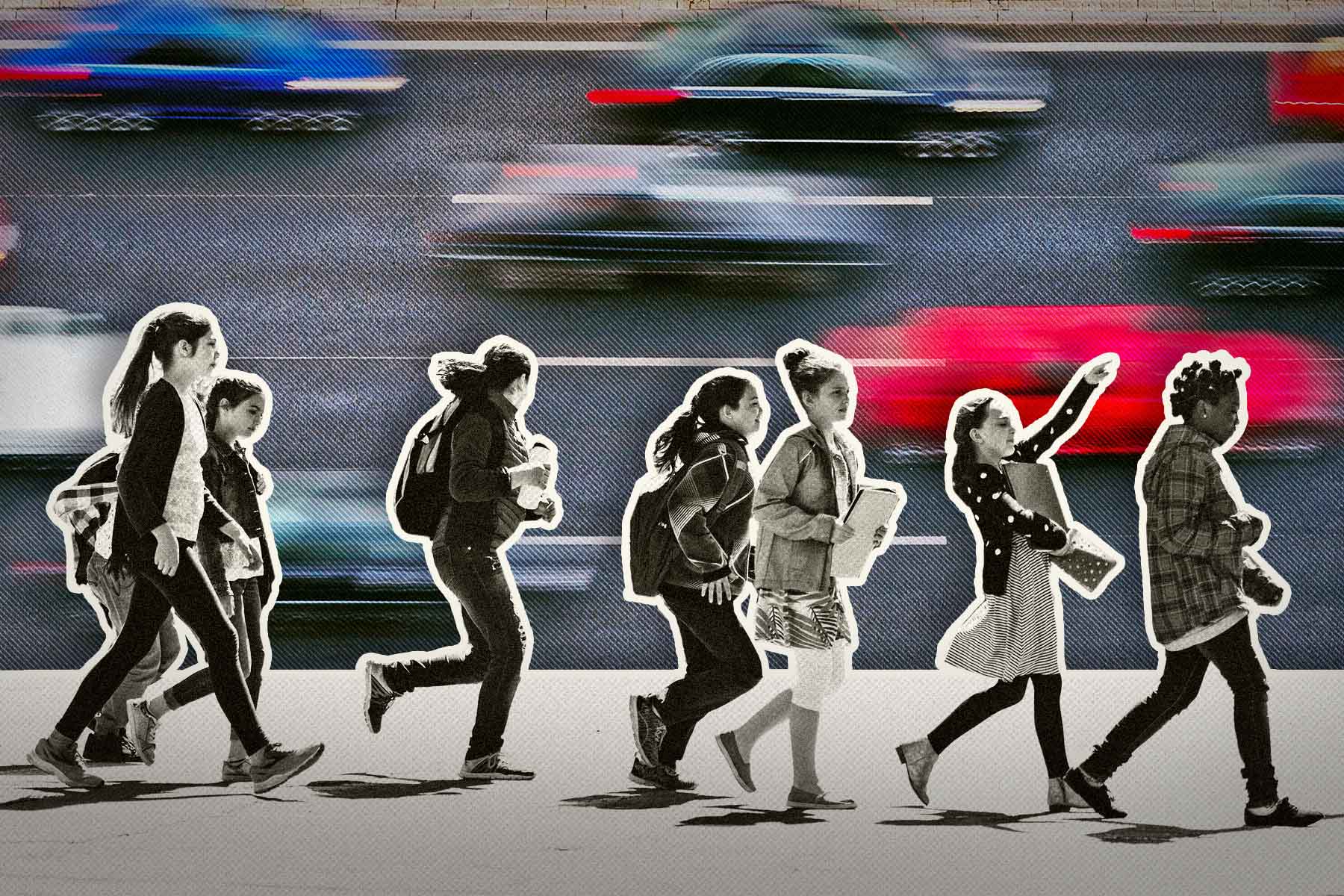Every weekday of the school year, my two boys, who are seven and eleven years old, run a life-threatening and—for a parent—terrifying gauntlet.
We don’t own a car and live about five blocks away from their school. That means they walk or ride their bicycles all year round, the same way I did when I was a kid. In spite of the fact that our neighbourhood is one of the most walkable in Montreal—and possibly all of Canada—a large number of parents chauffeur their children to school in cars, pickups, SUVs, and minivans.
It’s especially intense at 8:25 in the morning, when parents in a hurry are dropping their kids off. My boys are still young enough that my wife or I walk or bike alongside them every day. And, over the past several years, we’ve seen some nasty things.
Parents parking on the sidewalk. Idling in the crosswalks. Flinging doors open too quickly. Pulling away from the curb and nearly taking out kids on bikes who sometimes ride down one-way streets in the direction opposite to that of the permitted traffic “flow.” Many drivers seem to want “rockstar” parking and jostle for space as close to the schoolyard entrance as they can possibly get. I’ve come to think of the drop-off experience as our daily rodeo, and I’ve trained our kids to dismount from their bikes as they approach school, use the crosswalks, and obey the (likely overworked) crossing guard. There have been near misses—I’ve personally witnessed at least a dozen. Late last year, Maria Legenkovska, a seven-year-old girl, was killed by a hit-and-run driver in another borough of Montreal as she was walking to school. She was a refugee and had arrived in Canada from Ukraine two months earlier.
Over the past few years, it’s been my fondest hope that Montreal would embrace a movement that’s spreading through Europe: “School Streets,” as they’re known in England, or “Rue aux Écoles,” as they call them in France.
Paris now has 180 of them; cars are either completely banned or are prevented from approaching by movable barriers during the times kids are arriving at or leaving school. In London alone, there are now over 500 school streets. One study from 2021 showed that 81 percent of respondents believed a school street was suitable for their school; the same study found that the measure “reduced nitrogen dioxide by up to 23 percent” during morning drop-off, and—this is crucial—nearly one in five reported driving their kids to school less often because of the change.
There are historical precedents for this. In the twentieth century, the UK had 700 “Play Streets,” where the road was closed to all “mechanically propelled vehicles,” allowing kids to get outside and be kids without the fear of being crushed. Such streets weren’t limited to Europe. New York had its own version, supervised by the police department, which let children escape tenements, get outside, and enjoy a game of kick-the-can or stickball.
Makes all kinds of sense when you think about it. In crowded cities, precious public space—the streets outside our houses and apartments—shouldn’t necessarily be used for warehousing private automobiles or hurrying the drivers of those automobiles along. “Streets and sidewalks—venues of myriad public activities as late as 1920,” writes transportation historian Peter D. Norton in Fighting Traffic: The Dawn of the Motor Age in the American City, were “redefined as exclusive transportation ways, subject to regulation in the name of efficiency.” We’ve all come to accept the idea that roads were built for cars—and they most definitely were not. As Carlton Reid has shown in his book Roads Were Not Built for Cars, most urban roads were first paved in the late-nineteenth century after intense lobbying by bicycle riders.
At our kids’ school, we’re trying to change that. What boggles my mind is that it’s seen as a radical proposition that streets outside the school should be closed, at least for part of the day, to traffic. The obstacles we’re running into range from objections from the borough’s traffic engineers to parents who express anger when they are asked not to park in crosswalks. How can our proposal even be controversial? Cars are a source of fine particulate matter, which can have a severe impact on kids’ respiratory health. Cars, especially pickups with enormous blind spots, are a manifest danger to children’s lives. And relying on cars for the school run sets a terrible example. We need to be encouraging walking, cycling, and other forms of active transport rather than strapping our kids’ asses to SUVs.
If any city in North America should be an early adopter of the school street idea, it’s Montreal. People here use transit—more so, by some measures, than those in any other major city on the continent. We have a great bikeshare system, in the form of Bixi, and extensive bicycle infrastructure, even if too much of it is still paint on pavement. The central city is eminently walkable. And we have a mayor in city hall, Valérie Plante, whose party, Projet Montréal, has made it a mission to make the city greener and more bicycle and pedestrian friendly. Yet the few tentative attempts at limiting car use around schools have run into opposition, and where they have been instituted, they appear to be nowhere near as well thought out or safe as those in Europe.
It’s bizarre. We are a society obsessed with the safety of our children, sometimes to a ridiculous extent. Yet when it comes to the school run, the automobile remains sacred. The attitude is frustrating—but also illuminating. It shows that if many of us make a good show of talking green, few of us actually get around to walking the walk.




